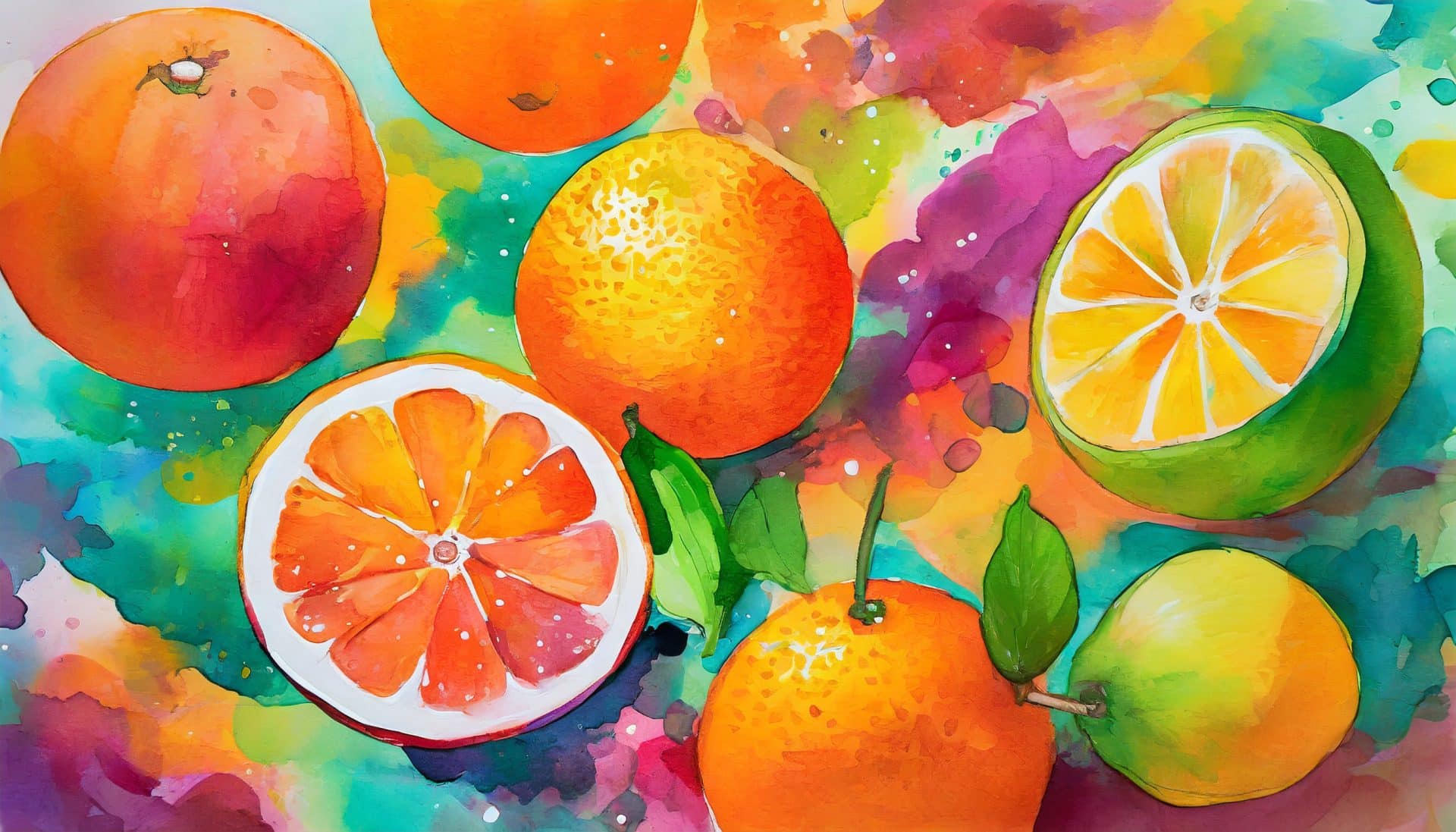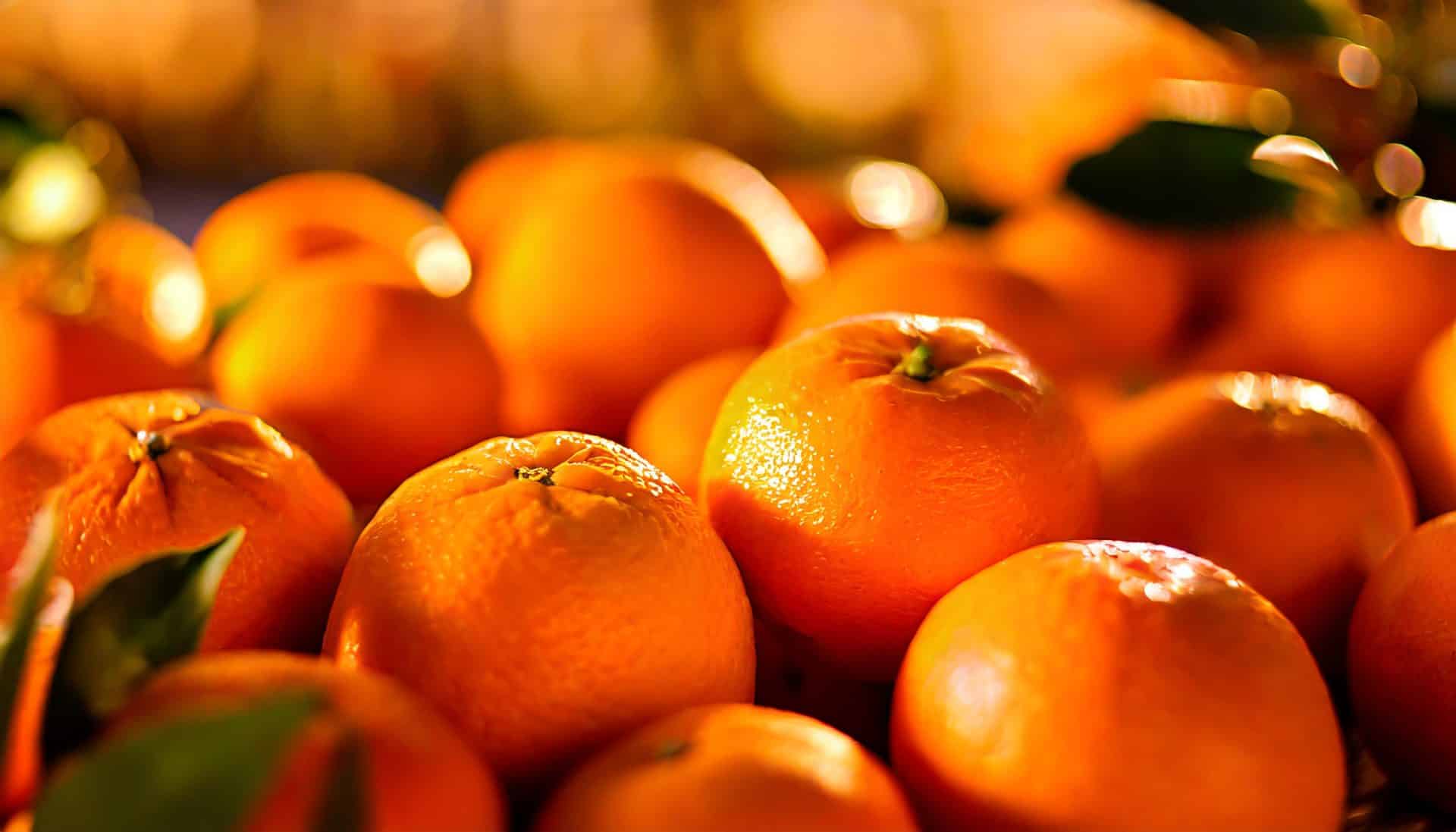Today’s journey will safely lead us through the paths of history, language, and the wonderfully colourful world of fruits.
We’ll explore:
- The origin of the word ‘orange’
- Historical use of the word ‘orange’
- How the colour and fruit are interconnected
Let’s start this vibrant voyage of discovery and paint a picture as bright and engaging as the colour itself. Ready? On we go!

The origin of the word ‘orange’
Indeed, the intriguing tale of the word ‘orange’ takes us far back in history. This trip started around 2000 years ago in Asia, where ancient Sanskrit scholars labelled a striking citrus fruit ‘naranga’.
As this word journeyed through various languages, it transformed. In the Arabic-speaking territories, the fruit was referred to as ‘naranj’, and over in Persia, it morphed into ‘narang’. As the fruit spread across continents, so did its name, changing subtly with each cultural exchange – just like a riveting game of linguistic ‘pass the parcel’.
Our narrative travels through Europe, where the intoxicatingly scented fruit found its way to Spain, Italy, and France. It transformed into ‘naranja’, ‘arancia’, and the French’ pomme d’orenge’, respectively. This last term, splendidly, translates to ‘fruit of gold’. But, in the name of linguistic ease, it was shortened to ‘orenge’, bringing us a step closer to the word ‘orange’ that we know today. This evolution of the word illustrates how languages can change just like the world around us.

The history of the fruit
Did you know that oranges have been around for a very long time? We’re talking thousands of years here! In Southeast Asia, these citrus fruits were originally a crossbreed between a pomelo and a mandarin. Neat, huh?
Oranges started their global journey via trade routes. First, they reached the Middle East and the Mediterranean region. They were cherished here for their sweet and tangy flavour (and unique colour!).
They eventually made their way to the Americas, thanks to Christopher Columbus. In 1493, he took seeds of oranges, lemons, and citrons with him on his second voyage. Imagine sailing across the vast ocean to introduce new fruits to a new land! Imagine that first juicy bite into a fresh orange! Doesn’t it make your mouth water?
The cultivation of oranges in the Americas took off in the 1500s when Spanish explorers planted the first orange trees in Florida–now a major producer of oranges. It’s mind-blowing how much history is tucked away within those juicy segments.
And lest we forget Europe! Sweet oranges were a luxury and a sign of prestige for a long time there. Indulging in orange was considered a rare treat and often associated with the holiday season (imagine getting an orange as your Christmas present–that must have been delightful!).
The orange is a reminder that life is full of zest.
Oranges Today
Fast forward to today, and oranges are one of the most cultivated fruits worldwide. Oranges and their products (think orange juice) are famous for their sweet-sour kick and high vitamin C content. You see, it’s not just the colour or the fruit’s origin that makes oranges fascinating; there’s a vibrant history behind each juicy bite you take!
Isn’t it amazing how something as seemingly simple as a fruit can have such an exciting journey, full of twists and turns, all the while bringing joy (and a lovely fresh scent) to people worldwide? It makes you appreciate every slice, every drop of juice a bit more.
The many versions of an ‘Orange’ fruit
Now, I bet you’re thinking, “Surely, there’s only one type of orange, right?” No, my friends, oranges come in a dazzling variety just waiting to be discovered. Let’s sink our teeth into this succulent world, shall we?
- The Bitter Orange: This variety originated in Southeast Asia and has acquired quite a global fan base – and we’re not just talking about folks who enjoy their marmalade a bit tangy. It has a rough, thick skin that’s usually used in candying or to produce orange zests.
- The Navel Orange: Ah, the navel orange—my personal favourite. This popular variety is so named because of the ‘navel-like’ formation opposite the stem end. Navel oranges have sweet, juicy flesh and are perfect for eating out of hand. Plus, they’re seedless, a real game-changer for some of us.
- The Valencia Orange: Named after the Spanish city, Valencia oranges are prized for their bright orange, smooth skin and vibrant, tasty juice. So, next time you’re sipping on a refreshing glass of orange juice, chances are, it’s made from Valencia oranges.
- The Blood Orange: Sounds a bit ominous. But fear not! The name refers to the beautifully deep, ruby-red flesh and juice of the fruit, which owes its unique colour to anthocyanin (the same antioxidant that gives blueberries their vibrant hue). Perfect for desserts, salads, or cocktails, these oranges add a lovely splash of colour to any dish!
We could go on about the many varieties of oranges (like the Seville, Bergamot, or Mandarin, to name a few), but you’ll get the idea. The world of oranges is more complex than you may have believed.

So, what came first?
Did you ever play the classic chicken or the egg causality dilemma? It’s like that when we ask what came first, the colour orange or the fruit? Well, it’s time for a drum roll as we unveil the mystery of the century!
As we’ve journeyed through the history of the fruit and delved into the origin of the word ‘orange’, the snippets of information gathered have led us to this — the fruit came first! Yes, the citrusy deliciousness we all relish scooped the title ahead of the vibrant hue.
Before the introduction of the energetic fruit – oranges- there was no word for ‘orange’ in English to describe the colour. It simply didn’t exist. People referred to the colour as a form of yellow or red. Amusing. Imagine, if we didn’t have the fruit, we might not have had an easy way to describe the autumn leaves or a stunning sunset.
Do we need words to see colours?
As intriguing and baffling as it might sound, this ability to perceive and comprehend colours strongly ties back to our knack for articulating them with words. Imagine, if you could not name a particular colour, would you still be able to identify it? Many language experts believe so. They say that even though you might not have a word for it, your eyes can see the shades and hues of different colours. We all remember being fascinated by rainbows as kids, right? Those stunning arcs of colours in the sky, even though we might not have known the names of all the colours at the time, we still admired their beauty.
However, imagine if we had more words for colours, could we see more shades? Well, it’s a question that piques my curiosity.
Knowing the names of colours may enhance our ability to discern, appreciate, and remember them, just like when we learned to name ‘orange’ for both a fruit and a colour. When you learned the word ‘orange’, you didn’t just learn to identify the fruit; you also created a relationship with a specific hue. You even began distinguishing it from closely related colours like red and yellow.
In essence, naming a colour doesn’t change what our eyes see but how we interpret what we see. Once you knew the word ‘orange’, you must have started noticing it everywhere. Cars, flowers, sunsets – they all started popping! Your vocabulary for colours had expanded, and you might have felt like your world had become a little more colourful.
So, to wrap it all up, whether it’s the fruit or the colour, the ‘orange’ puzzle makes for a fascinating exploration of language’s influence on our perception of the world and, more specifically, colours. Remember, though, regardless of whether the fruit or the colour came first, we’re just glad we have both. After all, what would a perfect summer’s day be without the sight of vibrant orange marigolds and the taste of freshly squeezed orange juice?
When life gives you oranges, make orange juice.

Controlling the mind through language
Isn’t it fascinating how words can shape our perception and understanding of the world? You see, way back in the annals of history (and in routes less obvious), controlling the language people use has been a powerful tool for moulding their thoughts and behaviour. It sounds like something out of a science fiction novel.
Well, it’s not as far-fetched as it might seem. Remember George Orwell’s dystopian masterpiece, ‘1984’? (It is a heavy read for youngsters like us. But stick with me here.) In ‘1984’, the government used ‘Newspeak’ to manipulate their citizens and control their thoughts. A diabolically clever idea, wouldn’t you agree?
By simplifying language and limiting vocabulary, the government can prevent rebellious thoughts before they even happen. If you don’t have a word for ‘freedom’, how could you even conceive of wanting it? It’s like trying to imagine a new colour when all you’ve ever seen are shades of orange!
Hang on a minute, I hear you say. That’s all good in a fictional world, but this doesn’t happen today. I wish you were right. But let me introduce you to ‘hate speech’ laws, which are in place in many countries today. These laws prohibit offensive, threatening or vile speech that targets someone based on their race, religion, gender, and the like.
Now, don’t get me wrong, hate speech is awful, and we should always strive for kindness and respect in the way we communicate. But we should also understand that moderate and rational-legal controls can, sometimes, be the first step on a slippery slope towards more oppressive speech regulations. If only all things were as simple as figuring out whether the colour or the fruit orange came first, eh?
Remember, always keep asking questions, exploring, and learning because that is how we grow. Language is an excellent tool, but it can be misused. Be sure to think for yourself, my young friends, no matter what words others use to try and paint your world. Because just as the word ‘orange’ doesn’t define the entire spectrum of light, words alone can’t define your perception of the world around you.

